LECTURE 1: Early embryogenesis, Early experiemnts, fate maps and how to clone a frog
1/23
There's no tags or description
Looks like no tags are added yet.
Name | Mastery | Learn | Test | Matching | Spaced |
|---|
No study sessions yet.
24 Terms
3 major things
Proliferation
Differentiaona
Pattern formation
where and when
Two important questions to answer
Cell differentiation→ how are genes switched on and off in different cell types
How does the right cell form at the right plance, how do patterns of cells form?
Example of cell differentiation
Cell of frog somite
(tissue that gives rise to muscle and other strucutures)
express the gene for muscle myosin
but
Immediate neighbours in the skin and neural tube do not
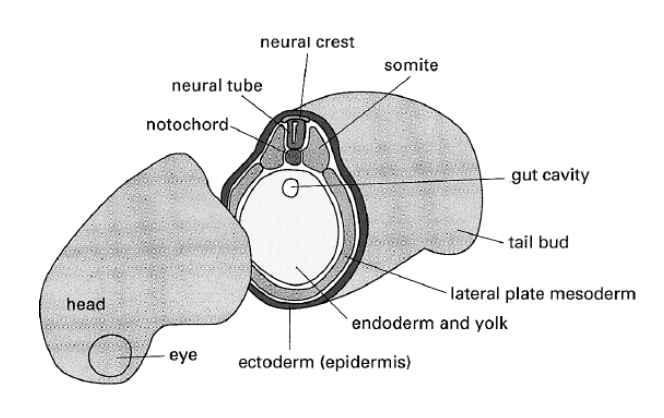
Examples of pattern formation
Cyanobacterium Anabaena
Forms heterocysts
specialised for fixation of nitrogen
How is this spacing controlled?
Hydra coelenterate
Head with tentacles and a mouth for ingesting prey organisms
AT OTHER END
foot for attaching to the substrate
what happens to hydra is cut in half?
Cut face of the foot end regenerates a head
The Cut foot of the face ende regernetaes a foot
→ Cell programmes are reset after cutting
makes the missing structure
BUT: how do cell ‘know’ where they are in the 2 halves
and form appropriate new strucutures?
Embryo develpooment in different species
sequence and pattern is very regular
Model organism egg developent
African frog→ Xenopus
divides to produce a ball of cells
→ called a blastula
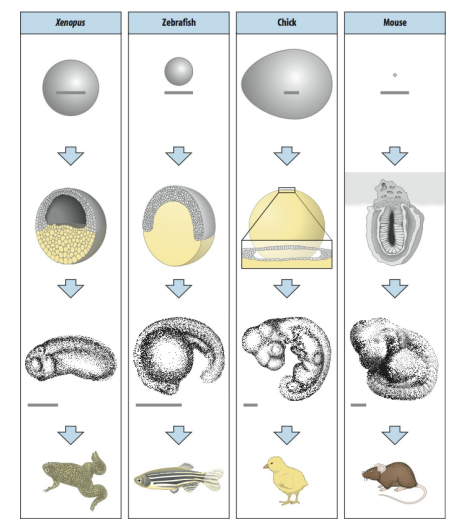
How to follow the fate of single cells?
Fate maps
inject cell in frog blastula with fluorescent dye
find out which cells are labelled in the developing frog
e.g cell C3 and its progeny appear to have contributed to muscle and skin
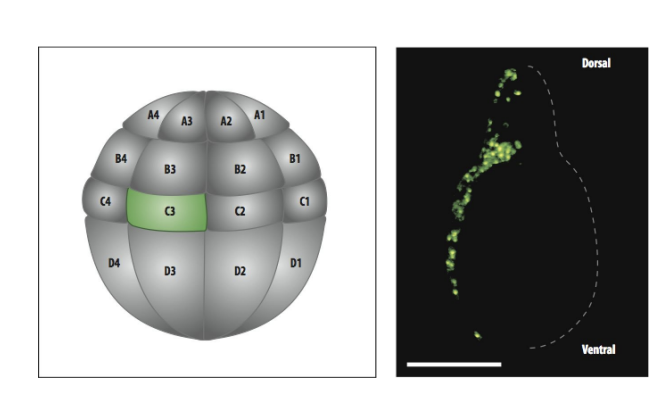
Fate maps: Why can they be made?
development is a regular process
can use many experiments to build up a complete picture of what each cell contribute to the final structure
→ easily map it back onto the early embryo
What a fate map does?
predicts the developmental fate
of each cell in the early embryo
E.g fate map for frogs helps to
predict the upper dorsal part of blastula→ future nervous system

Experiment to find out how cells know this: Wilhelm Roux 1
Hot pin to kill one of two cells formed in the frog’s first division
→ Result:
If LH killed→ only the right half of the embryo developed

1 Roux conclusion
Information necessary to make embryo was partitioned at each cell division
→ shown here as only right hand side destroyed
1 Flaw in the experiment and conclusions?
Could not remove the dead cell
→ Blocked normal development of the embryo on that side
Experiement 2: Hans Driesh
Separated the first two cells formed in sea urchin
cultured them individually
→ RESULT: any of these cells on its won was capable of forming an entire sea urchin embryo and larva
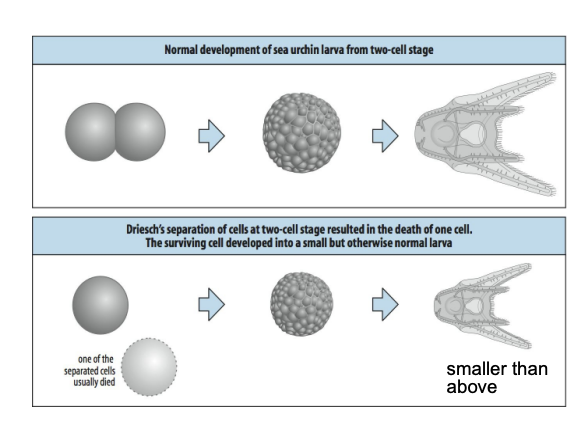
2 Conclusions from this
Embryo has self organising system
Could organise and recognise its own construction
→ even if it was cut in half
→ This is what developmental biologists seek to understand
Does information (DNA) get lost as the embryo develops?
e.g do skin cells speicialse becaus they lose genetically encoded info to make other cell types?
How answer this question?
Take a nucleus of a differentiated cell
adult skin cell or tadpole gut epitheial cell
Ask it to programme whole development
→ putting it back into enucleated egg cell
→ Nuclear transplantation
PLEASE LOOK AT STEPS→ keeps cytoplasm in tact

how to clone a frog→ Blastula
Albino nucelus in wild type ooctye
3 Experiement: Sir John Gurdon conclusions
nucleus is capable of orchestrating the complete developmet of a tadpole
even if it is differentiated
THEREFORE: Genetic encoded info is clearly not lost as cells differentiate
Then waht does happen to this information?
Not lost
Undertake specialised programmed of gene expression
With this techniques you can…
Clones genetically identical frogs→ cow
THEREFORE: no permanent loss of genetically encoded infor from differentiated cells
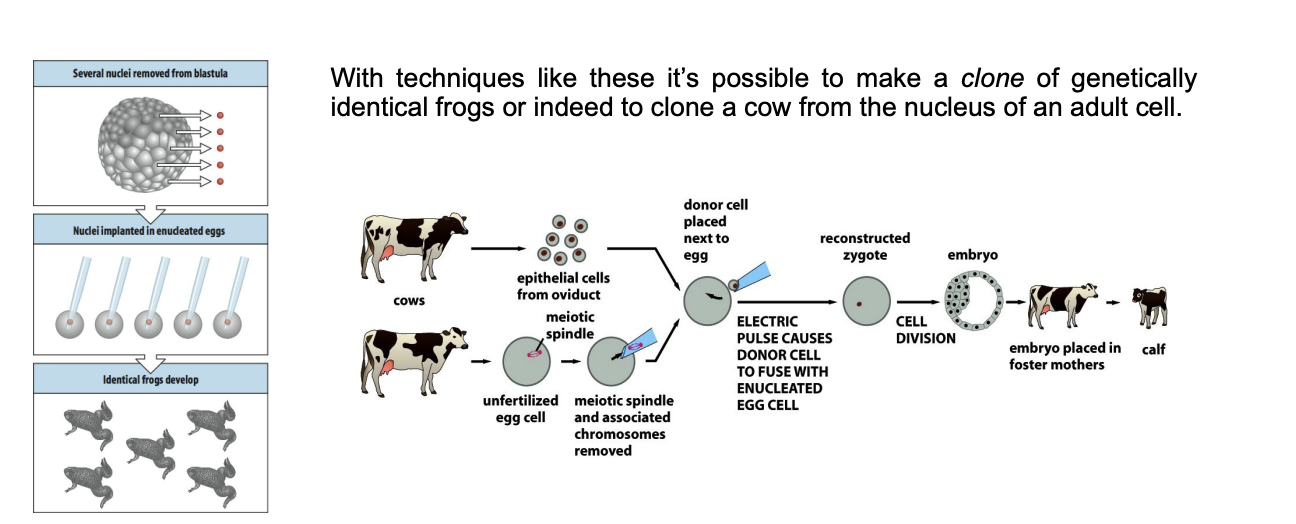
Cell differentiation therefore depends on…
the selective expression of parts
of a full set of genes
→ How do cells ‘know’ which genes to express?
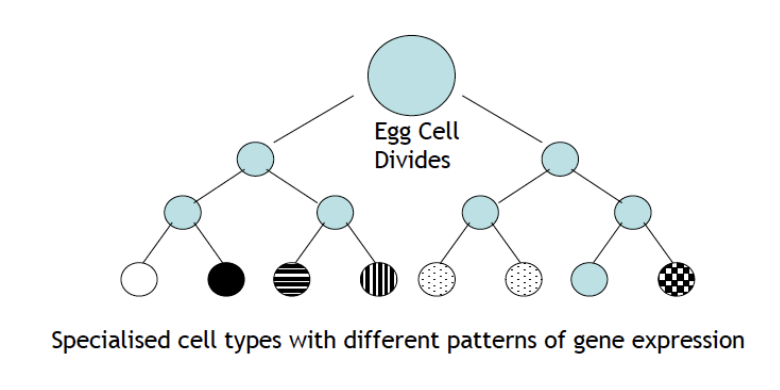
Additional information comes from two sources
Intrinsic: From inside
Asymmetric distribution of factors (determinants) as cells divide
Extrinsic: from outside
environmental cues
cells signal to each other
environmental signals influence cells